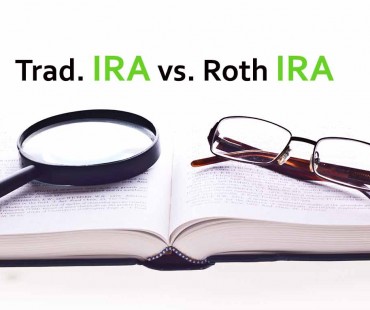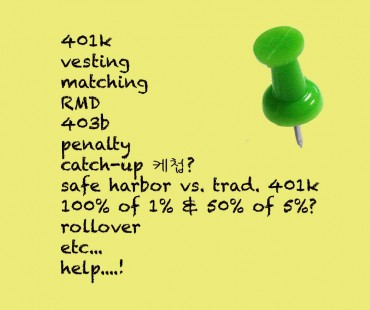401(k) and 403(b) are both employer-sponsored retirement plans, and the different names come from IRS section codes.
They work in a similar way, but the main difference is that 401(k)s are set by companies, while 403(b)s are by non-profit organizations such as schools, religious organizations, and hospitals. In both plans, individual accounts are set and the participants are responsible for their investment management. These retirement accounts are a great way for people to prepare for their retirement, so be sure to understand and take advantage of any plans that are offered to you.
Maximum deferral
This is the amount that employees can defer into their retirement accounts from their paychecks. It's $18,000 in the year 2015, but those who are 50 or older can put in an extra $6,000 for a total of $24,000. Depending on your plan, if you have ownership or your compensation is on the high-end of the scale within your organization, i.e. you are a highly compensated employee (HCE), you may not be able to contribute to the maximum limit.
Employer match
This is the amount your employer contributes on your behalf, and depending on your plan, it varies between 1% and 6%. For example, if your employer matches 100% up to 3% and 50% up to 5% above 3%, then by saving 5% of your gross income, you'll be able to get an additional 4% from your employer with a total of 9% for your retirement savings! Not taking advantage of the employer match is like saying no to a 4% salary increase, in this case. Know how much you need to contribute to take maximum advantage of your employer's match, and minimally contribute that amount or percentage.
Roth 401(k)
Many 401(k)s have an additional Roth 401(s) option, which allows participants to choose either or both pre-tax and post-tax contributions. Like in Roth IRA, contributions in Roth 401(k) accounts are post-tax money, meaning income taxes were paid on them. The benefit of paying taxes now (instead of deferring them by saving in a regular 401k) on your contributions is that you never pay income taxes on the profits, no matter how big. One main reason for forgoing great income tax deductions is that people expect their incomes to grow in the future, so they would rather pay taxes now at a lower rate than pay at a higher rate at distributions. If you just started working and expect to make much more in the future, or if you believe that overall income tax rates will increase significantly in the future, paying taxes now may make financial sense. With Roth 401(k), you are not required to have RMD (see below). Employers don't generally provide a match on Roth 401(k)s, but if they do, the matching portion and profits from the employer contribution are taxable at distribution.
Profit Sharing
This is a feature that only 401(k) plans can have because non-profit organizations can't have "profits." If this is provided by your company, you can elect to put the money into your 401(k) account on top of the salary deferral.
Tax deduction
Unless it's Roth, all the amount that goes into qualified retirement plans are tax deductible. For example, if your effective income tax rate is 30% and you contribute $10,000 into your 401(k), you won't have to pay 30% income taxes on that amount. But if you do not contribute, you would have to pay $3,000 on taxes, taking home only $7,000.
Tax deferral
All the money inside of retirement accounts grows tax deferral, which is why you should maximize the contribution that you are allowed before saving/investing in other types of accounts. Your money can grow without having to pay any income taxes until you withdraw, which may be 10, 20, or 30 years from now. This is extremely powerful because your money can grow faster than can other investments in taxable accounts.
Vesting
This is a feature that Traditional 401(k) plans may have, and it tells you when your employer contributions become your money to take. In other words, if your company's plan is a Traditional 401(k) with a vesting schedule, some or all of the money that your company contributed on your behalf may be taken from the account if you leave before fulfilling the vesting period. For example, let's say that your annual salary is $100,000 and your company has a Traditional 401(k) with a 3% match and a three-year cliff vesting schedule. Then your company will contribute $3,000 per year, and if you leave in 2 years and 6 months, then $7,500 ($3,000 in year 1 + $3,000 in year 2 + $1,500 for 6 months in year 3) and any profit from that would be taken from the 401(k) account. If the vesting schedule is a five-year gradual, then 20% of the company match would be yours after year 1, 40% of it would be yours after year 2... and finally after 5 years, 100% will become yours to take if you decide to leave the company afterwards. People who plan to quit must especially understand their plan's vesting schedule. Safe Harbor 401(k)s don't have a vesting schedule, meaning 100% of the company's match immediately becomes the employees'.
Catch-up
This is an extra contribution you can make if you are age 50 or older. For the year 2015, it's $6,000, so if you are 50 years old, then you can defer $18,000 + $6,000, which is $24,000 of your salary without paying income taxes. Some 403(b) plans may allow an extra $3,000 for those with 15 or more years of service. Therefore, if you have a 403(b), are 50 or older, and have worked for the organization more than 15 years, then you may be able to defer up to $27,000 this year (2015). Check your plan document or talk to your plan administrator for details.
RMD (Required Minimum Distribution)
As stated earlier, contributions in these accounts are tax deductible AND income taxes are deferred, meaning no income taxes have been paid on the contributions and earnings. The money in those accounts can continue to grow until distributions or until you become age 70.5. But once you turn 70.5, you have to withdraw a required minimum distribution (RMD) yearly, and ordinary income taxes are paid on the distributions. Failure to take an RMD comes with a severe penalty at 50%, so pay special attention to it. Click here for more RMD rules on the IRS website.
Early Distribution Penalty
Since the great tax benefits mentioned above are provided to encourage people to save for retirement, the government imposes penalties on early distributions. In other words, taking advantage of the tax deferral benefits for too long will be penalized by a harsh 50% penalty, but distributions shouldn't be made too early (before age 59.5), either. As discussed above, all distributions from 401(k) & 403(b) are subject to ordinary income taxes. If distributions are made before a participant reaches 59.5 years of age, the penalty of 10% must be paid on top of ordinary income taxes. There are penalty exceptions such as death or permanent disability of the participant or divorce...and more. Talk to your plan administrator and/or financial advisor before considering early distributions.
Overall annual contribution
There is a maximum amount that can be contributed into anyone's qualified retirement account, whether it's from the employee's salary deferral or from the employer's contribution (match, profit sharing etc.) for the employee. The annual overall maximum is the lesser of either 100% of the employees' total compensation or $53,000 for the year 2015 ($59,000 for those age 50 or older). If you work for two or more companies that each offers a qualified retirement plan, you may be able to go over this limit. However, you can't own more than a certain amount of any company you work for, and your total salary deferral amount remains at $18,000 ($24,000 if 50 or older).
This is for general information only. Please refer to your plan document or administrator for specifics of your plan. 이 글은 일반적인 정보를 위한 것 입니다. 당신의 은퇴 플랜에 대한 자세한 정보는 플랜 서류나 담당자에게 문의 하기 바랍니다.
401(k)와 403(b)는 모두 직장을통해 들을 수 있는 은퇴플랜이며, 이름은 IRS의 section code이다.
두 플랜이 서로 아주 비슷하지만, 가장 큰 차이점은 401(k)은 영리를 목적으로 하는 회사들이, 그리고 403(b)는 학교, 종교 단체, 또는 병원 같은 비영리 단체가 할 수 있는 은퇴플랜이다. 두 플랜 모두 참가하는 직원의 개인 계좌가 트여지며, 각 개인이 투자에 대한 결정을 하게된다. 이 은퇴플랜들은 개인이 은퇴 준비를 할 수 있는 아주 좋은 방법이므로, 당신 회사가 이런 플랜을 제공한다면 잘 이해하고 최대한 이용하기 바란다.
최대 급여 공제 금액
직원이 자기 월급에서 은퇴계좌에 넣을 수 있는 한도는 2015년 현재 $18,000 이지만, 만약 당신이 50세, 또는 그 이상 이면 $6,000을 추가하여 최대 $24,000 까지 넣을 수 있다. 플랜 종류에 따라 다르지만, 만약 당신이 회사의 지분을 갖고 있거나 높은 보수를 받는 직원 중 하나라면, 이 한도가 오히려 줄어들 수도 있다.
회사의 매치분 (Employer match)
이것은 회사에서 직원들을 위해 계좌에 넣어 주는 부분으로, 회사의 플랜 마다 다르지만, 보통 1~6%이다. 만약 당신 회사의 은퇴 플랜이 당신이 넣는 3%까지는 100%, 그 이상의 5% 까지는 50% 매치해준다고 하면, 당신은 급여의 5%를 저축함으로써 회사에서 주는 4%를 받을 수 있으므로 결국 총 9%를 은퇴 계좌에 저축하는 결과가 된다. 그럼에도 불구하고 당신이 급여의 5%를 저축하지 않는다면, 당신은 4%의 임금인상을 거부하는거나 마찬가지다. 그러니, 당신 회사에서 매치해주는 최대한의 혜택을 얻으려면 당신이 얼마를 저축해야 하는지를 정확히 알고, 최소한 그 금액은 은퇴계좌에 넣기 바란다.
Roth 401(k)
많은 은퇴 플랜들은 직원들로 하여금 세금전과 후의 금액 중 하나, 또는 둘 다 납입할 수 있는 기회를 주기 위해 추가로 Roth 401(k)도 제공한다. Roth IRA 같이 Roth 401(k)에 납입되는 금액은 인컴택스를 낸 후의 돈으로 들어가는거다. (일반 401k 계좌에 저축함으로써 세금을 공제 받을 수 있음에도 불구하고) 지금 세금을 내고 Roth 401(k)계좌에 투자 하는 것의 혜택으로는, 그 돈을 투자하여 벌게되는 미래의 이익금이 얼마든 상관 없이 전혀 인컴 택스를 내지 않아도 된다는 거다. 지금의 적지 않은 세금 공제를 포기하는 사람들의 큰 이유중 하나는 그들의 인컴택스률이 미래에 크게 오를거라고 기대하기 때문에, 세금률이 낮은 지금 세금을 내고, 세율이 높아지는 다음에는 내지 않는것이 더 익이라고 생각하기 때문이다. 따라서, 만약 당신이 지금 사회생활을 시작하여 당신의 인컴은 앞으로 크게 오를것이라고 믿거나, 아니면 미래에는 모든 사람들의 인컴택스률이 크게 오를거라고 생각한다면, 지금 세금을 내고 Roth 401(k) 계좌에 저축하는것이 더 이익이 될 수도 있다.
회사의 이익 분배금 (Profit Sharing)
회사의 이익을 직원들에게 나눠주는 이 프로그램은 비영리 단체의 특상'이익금'이 있을 수 없으므로, 401(k)에만 주로 있다. 만약 당신 회사의 401(k) 플랜에 이 조항이 있다면 급여 공제금과는 별도로 은퇴계좌에 들어가도록 선택할 수 있다.
세금 공제
Roth가 아니라면, 은퇴계좌에 저축하는 돈은 세금공제가 된다. 예를 들어, 만약에 당신의 평균 인컴택스율이 30%이고 401(k) 계좌에 $10,000을 저축 하였다면, 그 금액에 대한 30%의 인컴택스를 내지 않아도 된다. 그렇지만 만약에 저축을 하지 않는다면, 당신은 $3,000의 인컴택스를 내고 $7,000의 세후 금액만을 집으로 가져가게 된다.
세금 유예
은퇴계좌에 있는 돈들은 계좌에서 돈을 꺼내기 전까지 모든 세금이 유예되므로, 이런 혜택이 없는 다른 계좌에 저축/투자 하기전에 은퇴계좌에 최대한 넣는것이 이익이다. 당신의 은퇴계좌에 있는 돈은 당신이 10년, 20년,또는 30년 이후에 돈을 찾아 쓰더라도 그때까지 세금을 내지 않아도 되기 때문이다. 그러면 당신의 돈은 세금을 내야하는 다른 계좌에 있을때 보다 훨씬 더 빨리 불어나는 엄청난 효과가 있다.
베스팅 (Vesting)
이것은 Traditional 401(k)에 있을 수 있는 하나의 조항으로, 회사에서 당신의 401(k) 계좌에 넣어준 금액을 당신이 그만둘때 얼마나 가져갈 수 있는지에 대해 알아 볼 수 있다. 다시 말해, 당신 회사의 은퇴 플랜이 베스팅 (vesting) 스케줄이 있는 Traditional 401(k) 라면, 회사에서 당신 계좌에 넣어 준 금액이 당신이 회사를 위해 일정기간 일을 하지 않고 퇴사 하게되면 일부, 또는 모두가 회사에 귀속될 수 있다는 것이다. 예를 들어, 당신의 연봉이 $100,000이고, 당신 회사의 401(k)는 3% 매치와 three-year cliff vesting 조항이 있다고 하자. 그럼 회사는 당신의 은퇴계좌에 해마다 $3,000 을 넣어 주게 되는데, 만약 당신이 2년 6개월만에 퇴사를 하면, 당신 계좌에 넣어 주었던 회사의 매치분 $7,500($3,000 +$3,000+$1,500)과 그에 따른 이익금은 모두 회사에 귀속되게 된다. 만약 five-year gradual vesting 스케줄이라면, 회사에서 넣어 주는 금액의 20%가 1년 후에, 40%는 2년 후에... 그리고 5년이 지나서야 100% 모두 당신의 돈이 되며, 그때 퇴직하면 다 가져갈 수 있게 된다. 조만간 퇴직 계획이 있는 사람이라면 이 부분을 특히 잘 이해하여야 한다. Safe Harbor 401(k)에는 베스팅 스케줄이 없으므로, 회사가 적립해주는 금액은 100% 바로 직원의 돈이 된다.
켓첩 (Catch-up)
Catch-up (켓첩)은 50세, 또는 그 이상의 나이가 되면 추가로 넣을 수 있는 금액이다. 2015년 현재 $6,000 이므로, 만약 당신이 50세나 그 이상 이라면, $24,000 ($18,000 + $6,000) 까지 세금 공제를 받으며 저축할 수 있게 된다. 어떤 403(b)들은 그 외에도 15년 이상 근무자들에게 추가의 $3,000을 저축하게 하기도 하여, 그런 경우는 총 $27,000 까지도 소득세를 내지 않고 은퇴계좌에 저축을 할 수 있다. 당신이 가입한 플랜에 관한 자세한 내용이 알고 싶으면 플랜 서류를 살펴 보거나, 회사의 담당자에게 문의하기 바란다.
기본 출금액 (RMD-Required Minimum Distribution)
앞에서 설명 했듯이, 이 계좌들에 들어가는 돈은 세금 공제가 될 뿐 만 아니라, 투자 이익에 대해서도 세금이 유예된다. 즉, 원래 납입금과 투자 이익금 중 어느 하나에도 소득세가 물려지지 않았다. 이 금액들은 당신이 70.5세가 될떄까지 계속 세금을 유예 받으며 자랄 수 있다. 하지만 당신이 70.5세가 되면, 해마다 정부가 정하는 최소한의 금액을 출금 (Required Minimum Distribution) 하고 그 금액에 대하여 소득세를 내야 한다. 이걸 무시하거나 잊어 버리고 출금을 하지 않으면 그에 대한 과징금이 50% 이므로, 특별히 신경 써야 한다. 이에 관한 IRS 규정을 보고 싶으면 여기 클릭.
조기 출금에 대한 과징금 (Early Distribution Penalty)
위에서 언급한 많은 세금혜택은 정부가 사람들로 하여금 은퇴를 위해 더 저축하도록 장려하기 위해 주어진 혜택이므로, 조기 출금에 대한 과징금이 있다. 즉, 세금 혜택을 보려고 너무 늦게까지 (70.5세 이후) 출금을 안 해도 무려 50%나 되는 페널티가 있지만, 그렇다고 너무 일찍 (59.5세 이전) 출금을 해도 안되는거다. 위에서 설명 한대로, 40k(k) 와 403(b) 계좌들에서 출금 되는 금액에 대해서는 인컴택스 (ordinary income tax)를 내야 한다. 그런데, 만약 59.5살이 되기 전에 출금을 하면, 이 인컴택스 외에도 별도의 10% 과징금을 내야 한다. 계좌주의 영구적인 장애나 사망, 또는 이혼등에 의한 출금의 경우등, 여러가지 예외 조항은 있다. 만약 당신이 은퇴 계좌 에서의 조기 출금을 고려하고 있다면 플랜 담당자, 재무설계사와 상담하기 바란다.
은퇴계좌에 들어갈 수 있는 총 금액 (Overall annual contribution)
은퇴계좌에 저축하는 금액은 그것이 직원이 월급에서 적립하는 것이든, 아니면 회사에서 직원을 위해 적립해주는 것 (match, profit sharing.. 등)이든 상관 없이, 최대한으로 들어갈 수 있는 금액이 정해져 있다. 2015년 현재, 그 최대 금액은 직원의 연봉이나 $53,000 (50세, 또는 그 이상인 사람은 $59,000) 중 적은 것이다. 만약 당신이 은퇴 플랜을 제공하는 두 개의 다른 회사에서 일을 한다면 그 금액이 초과 될 수도 있다. 그런 경우에, 당신은 어떤 회사든 일정 부분 이상의 지분이 있으면 안되고, 당신이 급여에서 공제하여 적립할 수 있는 금액은 총 $18,000을 넘을 수 없다 (50세, 또는 그 이상이면 $24,000).




